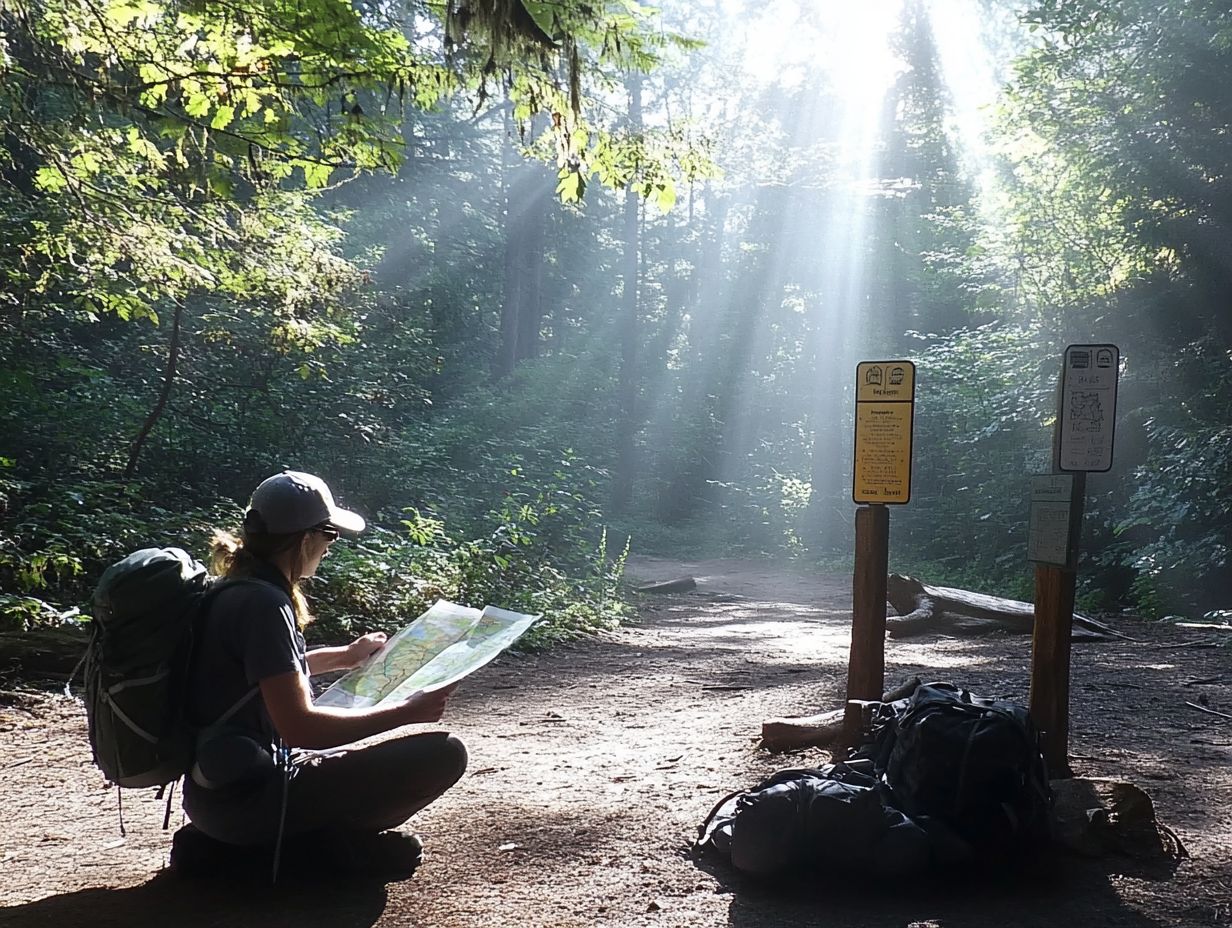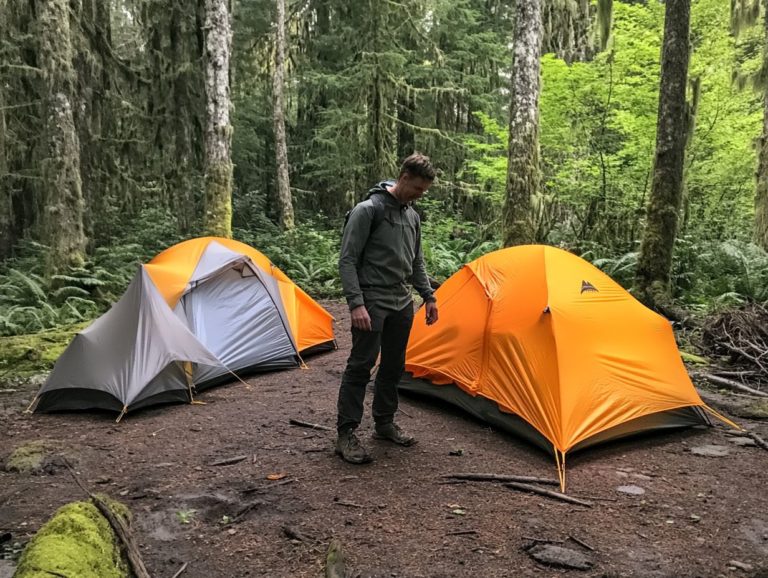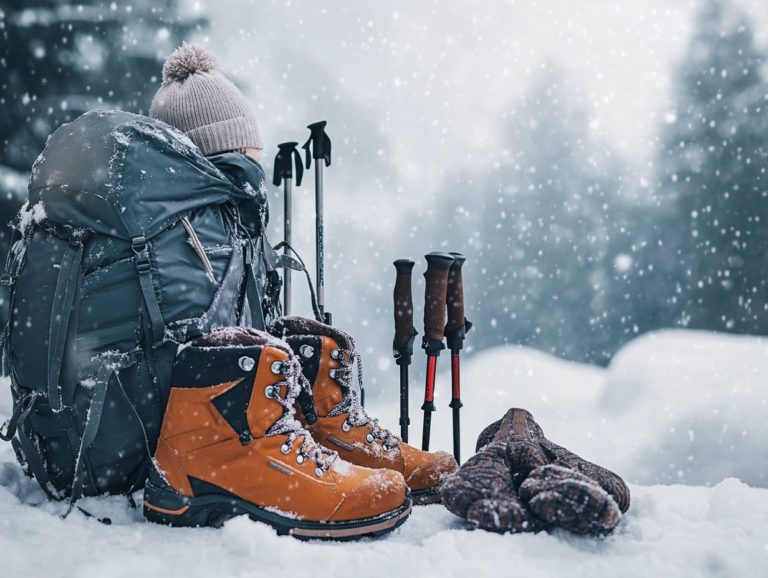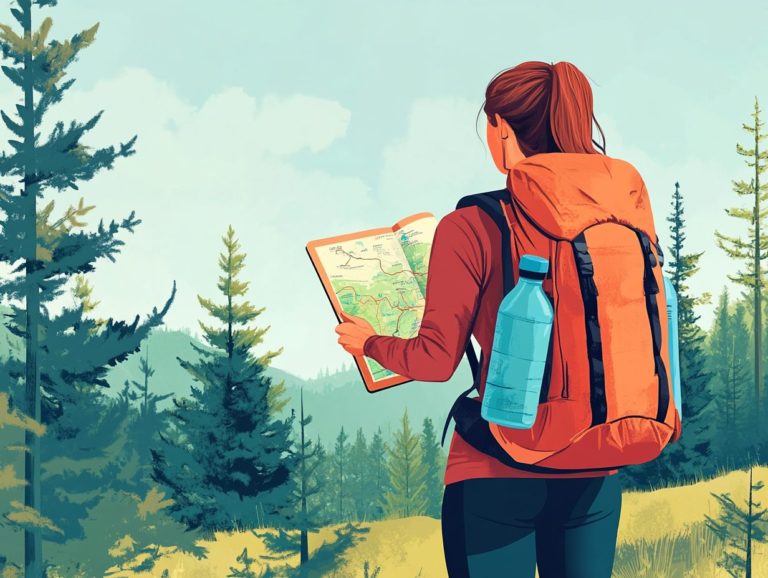How to Choose the Right Hiking Trail
Choosing the perfect hiking trail can elevate an ordinary day outdoors into an extraordinary adventure. There are a multitude of options for every fitness and experience level.
As you consider various factors from your current skill level and hiking experience to the distance you can dedicate it becomes essential to make a well-informed choice.
This guide will illuminate the key elements to help you select a hiking trail that aligns with your needs. It will also prepare you for a safe and enjoyable hike.
From gathering essential gear, like the right hiking shoes, to mastering trail navigation, you re poised to embark on your next outdoor adventure with renewed confidence!
Contents
- Key Takeaways:
- Factors to Consider When Choosing a Hiking Trail
- Researching Hiking Trails
- Mapping Out Your Hike
- Essential Gear for Hiking
- Tips for a Safe and Enjoyable Hike
- Frequently Asked Questions
- What should I consider when choosing a hiking trail?
- How can I determine the difficulty level of a hiking trail?
- What should I look for in terms of length when choosing a hiking trail?
- Is location an important factor when choosing a hiking trail?
- What are some important safety considerations when choosing a hiking trail?
- How can I find the best hiking trails in a specific area?
Key Takeaways:

- Know your physical abilities, experience, and the terrain when choosing a trail.
- Research trails using trusted resources like AllTrails or advice from experienced hikers.
- Plan your route by understanding maps and ensuring you have essentials like a first aid kit and snacks.
Factors to Consider When Choosing a Hiking Trail
Selecting the ideal hiking trail requires assessing several key factors. These can profoundly influence your outdoor adventures. Consider your current skill level, distance, the height you’ll climb, and the terrain type.
If you’re a beginner, you might gravitate toward well-trodden paths that offer easier navigation. Seasoned hikers may dive into moderate routes for an exciting challenge.
Know the hiking conditions, such as the weather, trail difficulty, and current conditions. This knowledge helps you craft adventures suited to your fitness level and personal preferences.
Physical Abilities and Experience
Your physical abilities and hiking experience significantly influence your best hiking trail, particularly if you re a beginner seeking suitable hikes.
A wise approach for those stepping into hiking for the first time is to choose trails that are clearly marked and designed for beginners. Consider the trail’s height gain, length, and terrain type. Focus on shorter, flatter trails that allow for a comfortable pace.
If you re a more seasoned hiker looking to enhance your outdoor experience, consider exploring moderate routes that present more of a challenge.
Using apps and websites dedicated to hiking can help you align your trail choices with your fitness level and preferences. Joining local hiking groups can offer valuable insights and foster a sense of camaraderie within the hiking community, enriching and enjoyable your outdoor adventures.
Time and Distance
When planning your hike, understanding the roundtrip distance and elevation changes is essential for ensuring a rewarding experience.
Estimating the time your hike will take based on the trail s height and distance enhances your safety and boosts your confidence on the trail. Use various hiking resources, like trail finders and mobile apps, which offer vital information about trail lengths and height changes.
Remember that your personal hiking pace and current fitness levels significantly impact the time required to complete your trek. Evaluate your stamina and select trails that align with your abilities, allowing plenty of time for breaks and enjoying stunning scenery.
So grab your gear and hit the trails your adventure awaits!
Difficulty Level and Terrain
Evaluating the difficulty level and terrain type of a hiking trail is crucial for ensuring a safe and enjoyable experience, particularly when selecting from the array of popular trails that cater to various skill levels, including those found in National Parks.
Understanding how these ratings are categorized can significantly enhance your hiking journey. For instance, you might encounter trails ranging from easy, flat paths perfect for families to challenging rocky inclines that require both physical endurance and keen navigation skills. To choose the best trail for your adventure, consider how to choose the right trail map. It’s essential to check hiking resources for updates.
Different terrains be it forests, mountains, or coastal areas bring their own unique challenges, including unpredictable weather conditions and varying levels of technical skill required. Therefore, assessing the current weather before heading out is vital.
Be honest about your skills and assess your capabilities while considering factors like the time of year and weather forecasts, which can drastically affect trail conditions and your overall hiking experience.
By using online resources, including AllTrails and the Hiking Project, along with hiking apps that offer curated recommendations, you can discover trails that align more closely with your preferences and comfort levels. Additionally, knowing how to select a hiking buddy ensures a rewarding adventure every time.
Researching Hiking Trails
Explore the many hiking resources online to find your perfect trail! You can check out a range of hiking resources available online, explore local guidebooks, and delve into outdoor blogs, including popular platforms like AllTrails, to gather crucial information.
This preparation enhances your experience and keeps you well-informed for your journey ahead.
Online Resources and Guidebooks

Online resources and comprehensive local guidebooks, such as the Hiking Project, are invaluable assets for discovering the best hiking trails tailored to your preferences and skill level.
These tools appear as user-friendly websites and innovative mobile apps, offering not only detailed trail maps but also real-time user reviews and updates on current conditions, enhancing your ability to navigate the trails. With a variety of platforms at your fingertips, you can confidently navigate challenging routes or stumble upon hidden gems that might otherwise remain undiscovered.
Local guidebooks excel at unveiling lesser-known trails, enriched with insights from seasoned hikers who have traversed these paths, providing essential hiking tips for new explorers.
These resources give you a strong understanding of your hiking options, boosting your safety and enjoyment on the trails.
Talking to Experienced Hikers
Engaging with seasoned hikers in the hiking community can offer you insights and tips that you simply won t find in online resources or guidebooks.
By connecting with fellow outdoor enthusiasts, you unlock a treasure trove of knowledge that extends beyond mere trails and maps. Attending local meet-ups within the hiking community opens doors to new friendships, story exchanges, and the discovery of hidden gems in the wilderness. Participating in outdoor forums provides an invaluable platform for sharing experiences and advice, enabling you to navigate new trails with confidence.
Being part of this community sharpens your skills and boosts your safety, as experienced hikers often share crucial information about potential hazards, trail conditions, or changing weather conditions.
Ultimately, immersing yourself in the hiking community can transform each adventure into a rich learning experience, making it easier to challenge friends and learn from each other.
Mapping Out Your Hike
Mapping out your hike is crucial for safe navigation and effective adventure planning. It’s important to grasp the intricacies of trail maps and markers which indicate the path and directions before you set foot on the trail, especially when considering distance and elevation gain.
This preparation not only enhances your experience but also ensures you re well-equipped to tackle whatever the trail throws your way.
Understanding Trail Maps and Markers
Understanding trail maps and markers is essential for you as a hiker. It significantly enhances your ability to navigate the trail and assess its difficulty level.
A well-designed trail map typically incorporates crucial elements, such as symbols representing various terrain types, points of interest, and potential hazards. This design greatly assists in your ease of navigation.
Grasping the scale of the map allows you to gauge distances effectively. This enables you to plan your journey with confidence.
Elevation profiles play a vital role; they illustrate the ups and downs of the trail, highlighting how steep certain sections may be. This directly impacts the overall difficulty.
If you’re venturing into challenging terrain, such as those found in National Parks, it’s imperative to familiarize yourself with how to find your way. Carrying a compass and knowing how to read both the map and compass will ensure accurate navigation, especially when visibility is compromised or paths are obscured by foliage or adverse weather conditions.
Planning for Rest Stops and Emergencies
Planning your rest stops and emergency supplies will elevate your hiking experience. It ensures you are well-prepared for the diverse conditions you might encounter on the trail.
One key strategy involves assessing the trail’s difficulty and distance. Understanding how strenuous each section is enables you to identify optimal rest points.
These rest points can enhance both your physical endurance and overall enjoyment of the hike. It s equally important to carry essential emergency supplies like a first aid kit, snacks, and extra water.
These items can make a significant difference in unexpected situations, turning potential challenges into manageable hurdles. Familiarizing yourself with the nearest exit points or shelters adds an extra layer of safety and peace of mind.
With this knowledge, you can navigate your way to safety should the need arise. This allows you to focus on enjoying the beauty of your surroundings.
Essential Gear for Hiking
Equipping yourself with the right gear is crucial for fully embracing outdoor adventures. It safeguards your well-being and enhances your comfort while ensuring you’re well-prepared for a variety of hiking conditions.
What to Bring and Wear

Knowing what to bring and wear on your hike can truly transform your overall experience. This is especially true when it comes to comfort and safety.
Selecting the right clothing layers is essential think moisture-wicking base layers, cozy insulating mid-layers, and a weather-resistant outer layer. These will help you adapt seamlessly to unpredictable temperature changes.
Sturdy hiking shoes tailored for the terrain will provide the traction and support needed to keep you safe on your journey. Packing essentials like a reliable water bottle, trail snacks, a first aid kit, and a map or GPS device can significantly enhance your trek.
These thoughtful preparations reduce the chances of unexpected discomfort or mishaps. By focusing on appropriate gear, you elevate your adventure, paving the way for unforgettable experiences in the great outdoors.
Emergency Supplies
Carrying emergency supplies is crucial for your hiking safety. This ensures you’re fully prepared for any unexpected situations that may arise during your adventures.
A well-stocked first-aid kit is critical. It addresses everything from minor cuts and scrapes to more serious injuries.
Having navigation tools like a map or GPS device is essential to avoid the disorienting experience of getting lost in unfamiliar terrain. Communication devices, such as a fully charged cell phone or a satellite messenger, are vital for reaching out for help if the need arises.
Beyond simply packing the right gear, familiarize yourself with basic survival skills and have a clear plan for emergencies. This includes knowing what to do if someone gets injured or lost. This preparation significantly enhances the safety of your trail experience.
Tips for a Safe and Enjoyable Hike
To guarantee a safe and enjoyable hike, embrace essential hiking tips that emphasize proper hydration, nutrition, and a deep respect for the outdoor environment through the Leave No Trace principles.
Gear up and hit the trails confidently!
Proper Hydration and Nutrition
Staying well-hydrated and nourished is essential for hiking, directly affecting your ability to keep going and enjoy your time on the trail.
Hydrating is crucial! Drink up to keep fatigue away and enjoy the stunning views. Carry a hydration system, like a CamelBak or easy-to-replace water bottles, so you can sip effortlessly without breaking your stride.
When it comes to snacks, choose nutrient-dense options to fuel your body effectively. Pack:
- Trail mix loaded with nuts, seeds, and dried fruit.
- Energy bars rich in whole grains and made with natural ingredients.
These selections not only sustain your energy but also provide essential vitamins and minerals for peak performance while exploring the trail.
Leave No Trace Principles
Following Leave No Trace principles is vital for preserving our parks and trails, ensuring that future generations can enjoy their own outdoor adventures.
By being mindful of your actions in nature, you can significantly reduce your environmental impact. These principles guide you toward sustainable practices that protect ecosystems and maintain the delicate balance of natural habitats.
Focusing on education and mindfulness helps preserve stunning landscapes while enhancing your own experiences. You will forge a deeper connection with the environment.
Understanding and implementing these guidelines fosters a culture of respect for nature, enriching your outdoor journeys and nurturing a sense of stewardship among all who share this passion.
Frequently Asked Questions
What should I consider when choosing a hiking trail?

When choosing a hiking trail, consider difficulty level, length, location, and scenery. These aspects help determine if the trail suits your fitness level and preferences.
How can I determine the difficulty level of a hiking trail?
The difficulty level of a hiking trail is often indicated by a rating system or symbols found on trail maps or at the trailhead. Be sure to select a level that matches your experience and abilities.
What should I look for in terms of length when choosing a hiking trail?
Trail lengths can vary greatly. Think about your fitness level and how much time you have. Remember that the length listed may not include side trails or detours.
Is location an important factor when choosing a hiking trail?
Yes, location can greatly impact your experience. Check if the trail is accessible, any potential safety concerns in the area, and if the scenery appeals to you.
What are some important safety considerations when choosing a hiking trail?
Consider the difficulty level, terrain, weather conditions, and potential hazards like wildlife or steep drops. Always inform someone about your planned route and estimated return time.
How can I find the best hiking trails in a specific area?
Many resources are available to help you find the best hiking trails. Search online for hiking websites or forums, ask locals for recommendations, or consult hiking guidebooks or maps.
Have you hiked recently? Share your experiences and tips with us!





